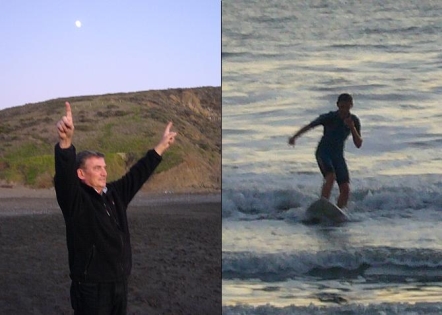|
I want to call out to him things like "Go further out!", "Paddle more to your left - there's a sandbar causing a wave to peak!", "There's a set coming. Let the first one go. The ones at the back are bigger!" ... but I don't. As hard as it is, I bite my tongue and stay quiet. This is Joshua's experience - not mine - and I want him to have it for himself. The time has come for me to get out of his way.
He chooses his wave, a nice unbroken swell, turns toward the beach and starts paddling. The wave gently picks him up; he rises onto his knees ... and then he's standing up! Joshua is standing up on his first attempt riding his first wave on his first surfboard, and I'm cheering him on, all the way to the beach. The gremmies at Surfers' Corner are cheering him on, all the way to the beach. The sophisticats at Kom Inner are cheering him on, all the way to the beach. The watermen at Jeffrey's Bay are cheering him on, all the way to the beach. The rite de passage has run its inexorable course. The torch is passed.
You can't really describe what it's like to surf, any more than you can describe what a grape tastes like or what transformation is like. They have to be experienced to be fully appreciated. And as for describing what it's like watching your son surf for the first time, that's even harder. It's awesome. It's sublime. You have to experience it for yourself to appreciate the fullness of it, to revel in the satisfaction of it, to celebrate the triumph of it, to realize the passing the torch of it.
